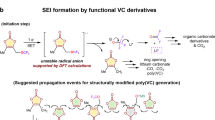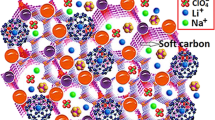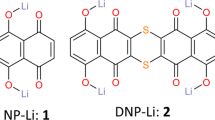Abstract
THE development of low-cost, solid-state rechargeable batteries is of considerable technological importance. A key requirement of such batteries is that the density of energy stored electrochemically in the electrodes is high. In this context, the use of organic materials has attracted interest; they combine high theoretical energy storage capability with low weight and good mechanical strength. Here we report the development of a rechargeable lithium battery with a composite organic cathode based on a mixture of a dimercaptan and polyaniline. The redox behaviour of the dimercaptan, which is normally too slow for practical applications1,2, is accelerated when coupled to that of the polyaniline3–5 (which itself functions as an active cathode material). Intimate mixing of the two materials is achieved by casting them jointly from solution. The resulting electrode can be repeatedly charged to near its theoretical limit and discharged. The gravimetric energy density of our materials exceeds that of the oxide electrodes in commercially available lithium-ion batteries6, a feature that is likely to prove advantageous in applications where weight, rather than volume, is a critical factor.
This is a preview of subscription content, access via your institution
Access options
Subscribe to this journal
Receive 51 print issues and online access
$199.00 per year
only $3.90 per issue
Buy this article
- Purchase on Springer Link
- Instant access to full article PDF
Prices may be subject to local taxes which are calculated during checkout
Similar content being viewed by others
References
Liu, M., Visco, S. J. & De Jonghe, L. C. J. electrochem. Soc. 138, 1896–1895 (1991).
Liu, M., Visco, S. J. & De Jonghe, L. C. J. electrochem. Soc. 138, 1896–1901 (1991).
Oyama, N. et al. Proc. New Sealed Rechargeable Batteries Supercapacitors (eds Barnett, B. M. et al.) 379–388 (Electrochemical Soc, Pennington, 1993).
Sotomura, T., Uemachi, H., Takeyama, K., Naoi, K. & Oyama, N. Electrochim. Acta 37, 1851–1854 (1992).
Sotomura, T., Uemachi, H., Miyamoto, Y., Kaminaga, A. & Oyama, N. Denki Kagaku 61, 1366–1372 (1993).
Hoshino, K. et al. National tech. Rep. 40, 455–463 (1994) (in Japanese).
Abe, M., Ohtani, A., Higuchi, H. & Ezoe, M. Nitto Giho 28, 63–75 (1990) (in Japanese).
Author information
Authors and Affiliations
Rights and permissions
About this article
Cite this article
Oyama, N., Tatsuma, T., Sato, T. et al. Dimercaptan–polyaniline composite electrodes for lithium batteries with high energy density. Nature 373, 598–600 (1995). https://doi.org/10.1038/373598a0
Received:
Accepted:
Issue Date:
DOI: https://doi.org/10.1038/373598a0
This article is cited by
-
Reversible and high-density energy storage with polymers populated with bistable redox sites
Polymer Journal (2024)
-
A theoretical study of high-performance β-In2Se3 monolayer as the anode material for alkali-metal (Li/Na/K)-ion batteries
Journal of Materials Science (2023)
-
Conjugated sulfonamides as a class of organic lithium-ion positive electrodes
Nature Materials (2021)
-
Effects of silver nanoparticle on electrochemical performances of poly(o-phenylenediamine)/Ag hybrid composite as anode of lithium-ion batteries
Journal of Solid State Electrochemistry (2020)
-
Reversible multi-electron redox chemistry of π-conjugated N-containing heteroaromatic molecule-based organic cathodes
Nature Energy (2017)
Comments
By submitting a comment you agree to abide by our Terms and Community Guidelines. If you find something abusive or that does not comply with our terms or guidelines please flag it as inappropriate.



